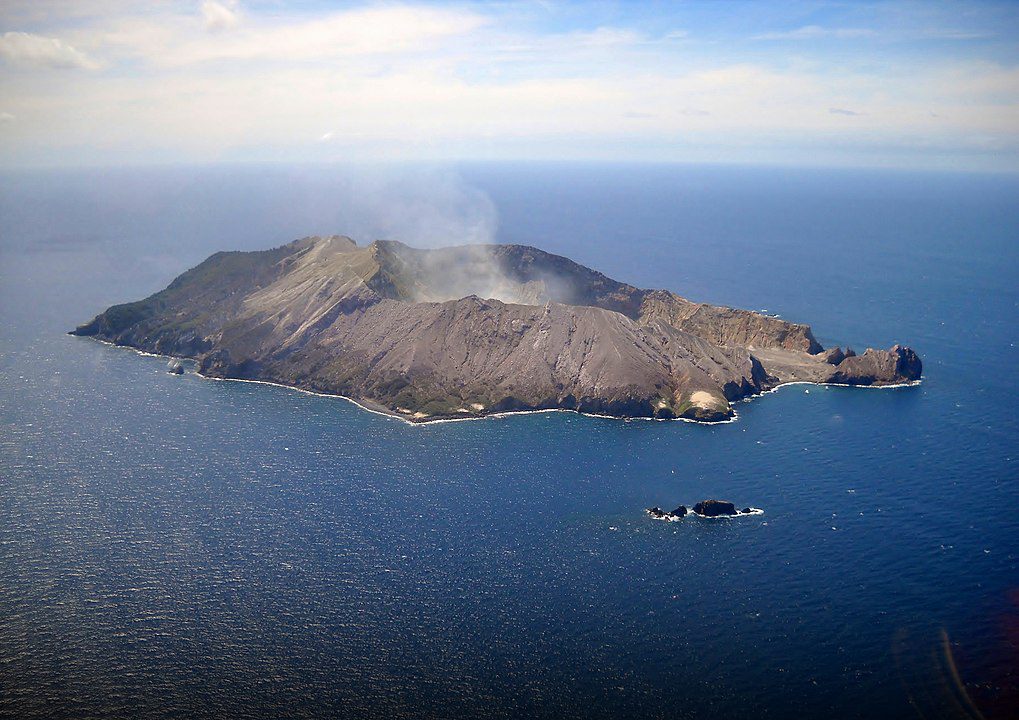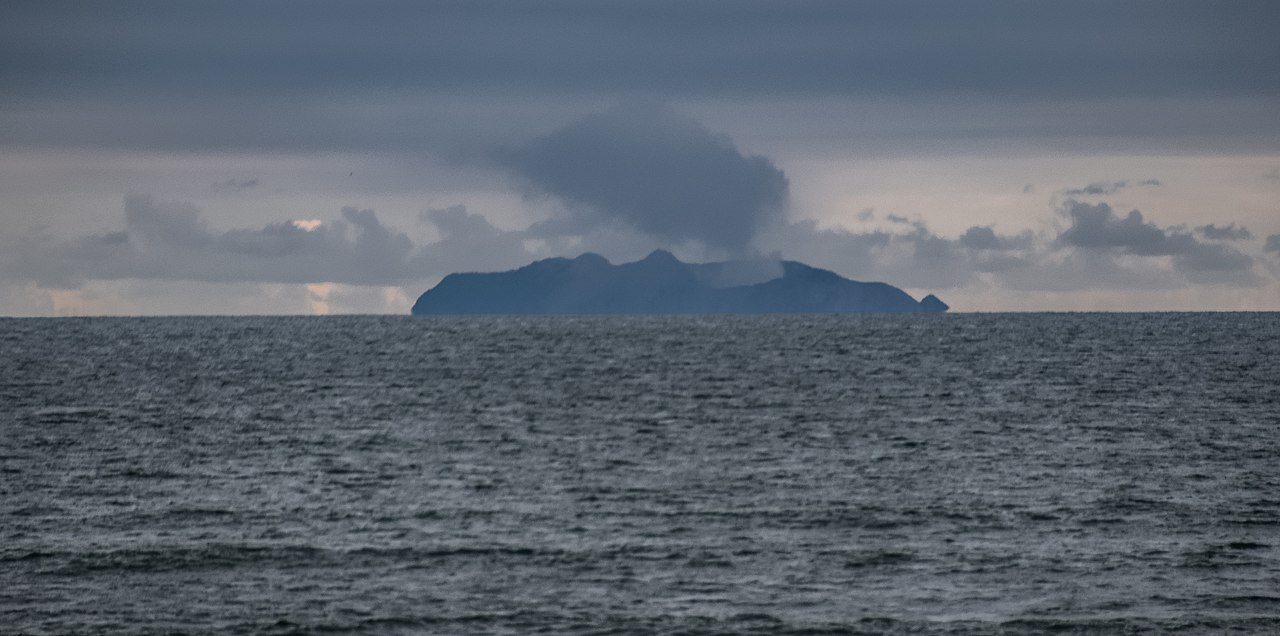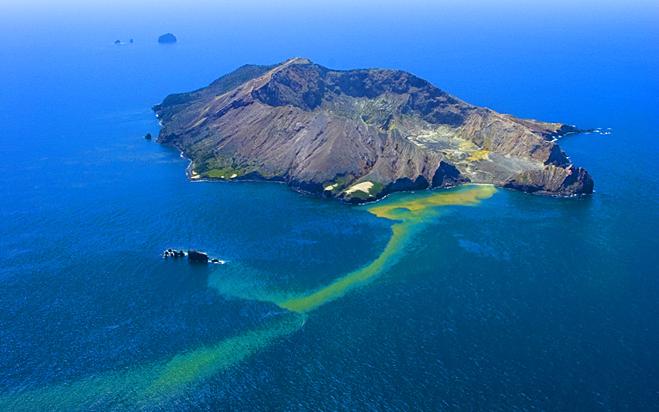
Whakaari/White Island. Photo by Gérard on Wikimedia
Top 10 Unknown Facts about Whakaari/White Island
Whakaari / White Island which is commonly known as White Island or Whakaari is an active andesite stratovolcano located 48 kilometres from the east coast of the North Island of New Zealand, in the Bay of Plenty. This Island covers an area of approximately three hundred and twenty-five hectares (800 acres).
The area covered by this island is just the peak of a much larger submarine volcano. The Island has been branded as New Zealand’s most active cone volcano which has been built up by continuous volcanic activities for over 150,000 years.
This island has been close to the near stage of releasing volcanic gas since it was sighted by James Cook in 1769. On 1st October 1769, Captain Cook named Whakaari White Island.
This name came from the dense clouds of white steam which were emanating from it. It is believed that Cook and his team sailed close to the island but did not record it as a volcano.
The official name of the island was changed from White Island (Whakaari) to Whakaari / White Island in 1997. It erupted continually from December 1975 up to September 2000.
However, it also erupted in 2012, 2016 and 2019. This island is among many places found in New Zealand that have dual Maori and English names.
Here are the top 10 Unknown Facts about Whakaari/White Island:
1. White Island Hosts One of the Most Active Volcanoes in the World
There are several active volcanoes around the world. Some of them are found on islands and others on dry land.
Whakaari/White Island hosts one of the most active volcanoes in the world. Whakaari is a Maori name which means dramatic volcano.
Since the first eruption about one hundred and fifty thousand years ago (150,000), White Island has been one of the most active volcanoes on earth. It is estimated that the volcano on White Island has erupted over fifty times since record-keeping began. Frequent and small eruptions usually take place on this volcano.
2. The Island is Constantly Changing Shape

Landing approach with a helicopter to the crater of White Island. Photo by Jens Bludau on Wikimedia
Over the years, White Island has been changing its shape. Several boulders and new cliffs are being formed on White Island.
Due to the ongoing eruptions, cones of all different shapes and sizes are being deposited. The melting lava also has put more effect and led to the constant changes on the White Island.
3. No Humans have ever Inhabited White Island
White Island has always been ranked among the most dangerous places on earth. This is due to a large amount of active volcanic activity on the island.
The volcanic activities have led to the production of dangerous gases which cannot be inhaled by humans. There are also dangerous cliffs around White Island.
Hot springs in several areas of the island have made this place uninhabited. No humans have ever inhabited the White Island since it was discovered and sighted.
4. It has been a Location for an Open, Highly Reactive Hydrothermal System

Whakaari/White Island in the Bay of Plenty in April 2019. Photo by Kimberley Collins on Wikimedia
The volcanic activities on White Island have made this area a source of energy. For thousands of years, White Island has been a location for an open, highly reactive hydrothermal system.
The highly reactive hydrothermal system of White Island has always been expressed as hot springs and mud pools. Fumaroles, acid streams and lakes have also made this area a hydrothermal system.
5. A Dangerous Eruption that Killed Several People Occurred in 2019
On 9th December 2019, a dangerous eruption occurred on White Island which claimed several lives. It started with background activity which increased with gas, steam and mud being ejected from the crater in November.
Forty-seven people were on the island when this dangerous eruption took place in 2019. Twenty-two people were killed, and twenty-five others were seriously injured.
The bodies of two missing people who were thought to be lost have never been retrieved. Heavy rainfall, low visibility and toxic gases hampered the search.
6. There are Four Different Maori Myths on the Formation of this Island

View of Whakaari/White Island from Ohope Beach, Bay of Plenty Region, North Island of New Zealand. Photo by Krzysztof Golik on Wikimedia
The Maori have usually come up with several myths about some of the landmarks in New Zealand. Four different traditional Maori myths talk about the formation of the White Island.
The first account stated that Tongariro called on his ancestors for warmth. The fire was started on Whakaari and brought to him.
In the second version of the myth, the sisters or the gods are the ones who sent the fire for warmth from Whakaari. The other myth state that the island rose from the deep after the god Maui touched fire and was in great pain.
He dived into the water to calm his pain and the Whakaari arose from this point. The last myth stated that Whakaari/White Island and Moutohora were peaking in the Huiarau range. They became jealous of each other and ran towards the sea.
7. Sulphur was once Mined at the Island
White Island has always been rich in several naturally occurring elements. Sulphur is one of the elements that is found on the island.
Mining of sulphur was once carried out on the island. The first attempt was in the mid-1880s, 1898 to 1901, 1913 to 1914 and 1923.
The island was owned by John Wilson from 1913 to 1914 when sulphur mining was done. However, in September 1914, a disaster occurred which killed ten workers.
Only a cat was found in the mining camp. In 1923, mining activities were approached with caution due to the previous disaster. No mining is carried out in recent days.
8. The Island is an Important Bird Area

Whakatane Waterfront of White Island. Photo by QFSE Media on Wikimedia
Due to the absence of human life on White Island, nature has taken over this area. This island is home and the main breeding colony for Australian gannets.
These birds flock on this island in thousands yearly to mate, raise chicks and feed on the fish. Seaweed grows mainly on the waters of the island which provides cooling to the gannet chicks.
Red-billed gulls, great-winged petrels and white-fronted terns usually inhabit this island. BirdLife International declared this area an Important Bird Area.
9. White Island is Privately Owned with Tourists Requiring Permit to Tour
There was a tussle over the ownership of the Whakaari/White Island for quite some time. It was later on decided to be handed private ownership.
The island is declared a private scenic reserve in 1953. Tourists are not allowed to access the island randomly. They have to get permission to tour and visit this area.
10. The Island Waters are Well Known for the Fish Stocks

Aerial photograph of White Island (Whakaari) in the Bay of Plenty, North Island, New Zealand. Photo by James Shook on Wikimedia
The Whakaari/White Island waters are full of different types of fish. They are famous for the fish stock like the yellowtail kingfish.
The deep waters have the hapuka and bluenose fish. In the summer, several blue, black and striped marlin fish and yellowfin tuna can be fished here.
Planning a trip to Paris ? Get ready !
These are Amazon’s best-selling travel products that you may need for coming to Paris.
Bookstore
- The best travel book : Rick Steves – Paris 2023 – Learn more here
- Fodor’s Paris 2024 – Learn more here
Travel Gear
- Venture Pal Lightweight Backpack – Learn more here
- Samsonite Winfield 2 28″ Luggage – Learn more here
- Swig Savvy’s Stainless Steel Insulated Water Bottle – Learn more here
Check Amazon’s best-seller list for the most popular travel accessories. We sometimes read this list just to find out what new travel products people are buying.









